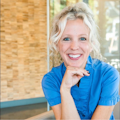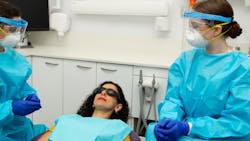At this point in my career, I feel very confident codiagnosing with the dentist, but at first this was very intimidating. As a new grad, I didn't even realize it was something hygienists could do. However, after sitting in on exam after exam, I started to realize that this is something I could take part in.
Ideally, we want to be in a practice where we’re comfortable with the doctor's diagnosing, and where we believe in and can support the doctor's work wholeheartedly, so much so that the quality is something we would recommend to others. If you can find a practice like this to work, it’s a wonderful situation because it makes codiagnosing easy. We’re more likely to speak effortlessly about something when we truly believe in it.
How to successfully codiagnose
When you first attempt codiagnosing, it’s useful to have meetings with the doctor to gain their permission and the autonomy to speak on their behalf. This way, you really do become an extension of them, and when you adopt their philosophy, you can listen in to why and when they recommend something or not. Now, imagine being a doctor with a hygienist who assists with outstanding treatment plans. It’s amazing to come into an operatory where the hygienist can help you focus on the patient's primary needs, which leads to far more efficiency and effectiveness.
You might be interested in: What happens when the hygienist and dentist don't agree?
The next step in codiagnosing is using the tools we have as dental hygienists. If the primary concern is periodontal, we may place the perio chart with the red numbers and the bleeding points on the monitor, or an image that radiographically shows calculus and bone loss. If the emphasis is on restorative, I get out my intraoral camera. Having your own camera in your operatory makes things so simple, and photos only take a minute or two. If I have to run around the office searching for a camera, it becomes an undertaking that I often avoid. Doctors who believe in the power of codiagnosing will be more than happy to supply their hygienist with a camera.
Let's say tooth number 14 has an ancient, corroded, fractured amalgam with caries. I take a photo and put it up on the monitor and sit my patient up to show them what I'm seeing. They'll take one look at that chart, x-ray, or image and ask questions. One of their first questions is usually, "What can we do about this?" This is when a confident, capable, codiagnoser explains why we do a crown and what the benefits are of going forward with treatment. This is the opportunity to explain how the excellent doctor is going to take wonderful care of them.
Now for the exam. How wonderful for the doctor to see the x-ray already sitting there, showing the bone loss or intraoral photo of the failing restoration. The doctor will support you and your recommendations. Let them come in and have a conversation with the patient about the weather, kids, or vacation—give that moment to them to connect. Then when they ask, “Is there anything I need to know?" this is your cue. Confidently explain that you and the patient have been looking at this photo together, and you really want to get the doctor's take on the situation.
Why your language matters
This is a very important part of codiagnosing. It's called codiagnosing for a reason. The language that we use as hygienists is very important. When we take the photo and explain to the patient what we think the doctor is going to recommend, it's important to say, "This is what I see and know, and if we go forward with treating this tooth today, this is the recommended procedure. However, we’re going to have Dr. So-and-So come in and give us his [or her] opinion."
This is an important piece of language because we really know what's going on, and we have a pretty good idea what the doctor is going to say and recommend, but we’re not technically diagnosing. Also, as an example, it's possible that the doctor could come in, and even though you have a beautiful photo of number 14, the bitewings aren't due for another six months. Then the doctor might say, "Hey, that's clinically not looking great, but I'd love to see a new set of images at your next hygiene visit just to make sure what's going on around and between those teeth." Because you've made this important distinction about the doctor’s opinion, it doesn't undermine your recommendations, and everyone's on the same page.
The more hygienists practice this, the more we and our doctors will combine as a force for good for our patients. If we’re able to codiagnose and improve the productivity and efficiency of the practice, we become an even bigger asset to the business. This is the definition of a win-win-win. The practice wins, the patient wins, and hygienists, with days filled with comprehensive care for patients, definitely win.
About the Author

Erika Flateau, RDH
Erika Flateau, RDH, has been a full-time clinical dental hygienist for 21 years. She developed a relational-based and revolutionary approach to hygiene care. She is regarded by dentists as having an unparalleled ability to connect with and engage patients as they discover their pathway to optimal health. She is effective at confidently educating others and “coaching them up” to a greatest potential.
